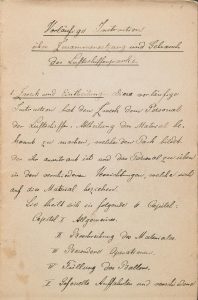
Today, August 19th, marks National Aviation Day and we’re celebrating with a lesser-known flying vehicle — the airship. Emil Schimpf’s ballooning manuscript Vorläufige Instruction über Zusammensetzung Gebrauch des Luftschifferparks was recently added to the Smithsonian Transcription Center and is available for crowd-sourced transcription.
Schimpf was a Second Lieutenant in the Badischen Pionier Bataillon Nr. 14, which was formed in the Grand Duchy of Baden in 1871. Schimpf was a member of the German balloon corp, which was organized in 1884. While the primary uses of ballooning at the time were mainly scientific and for leisure, military applications were also being explored.
Schimpf’s manuscript contains notes from an unidentified manual pertaining to the construction and use of airships for military purposes along with the information on the use of aeronautic parks. The manuscript also provides details on the care and maintenance of balloons along with the details on the use of hydrogen.

The production of hydrogen was a time-consuming and expensive process. Known as inflammable air, hydrogen was first produced using iron filings and sulfuric acid. An advancement to the process was developed by the French chemist Antoine Lavoisier and engineering officer/inventor Charles Meusnier. The process involved passing steam through a red-hot iron cannon. With some improvements, the Lavoisier-Meusnier process became the most efficient means of generating hydrogen for inflating balloons.
The Schimpf manuscript offers an invaluable window into the use of airships for military purposes. The manuscript was a gift of Bern Dibner and now resides in the Dibner Library of the History of Science and Technology. With the manuscript’s debut in the Smithsonian Transcription Center, we look forward to seeing what other secrets the public uncovers.

Be First to Comment